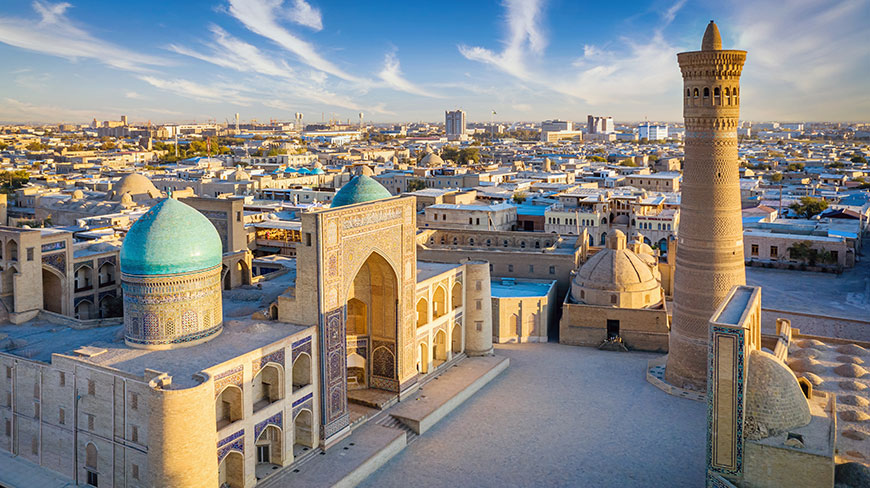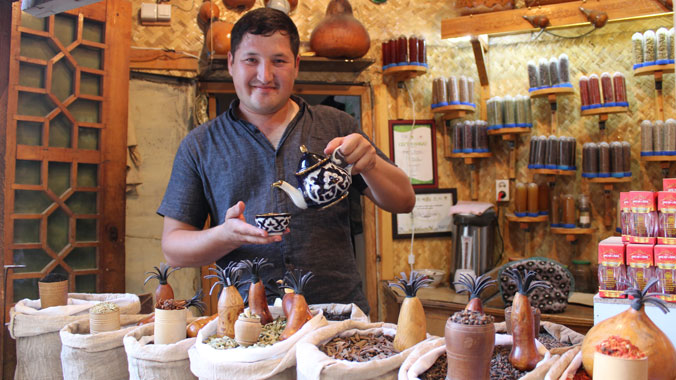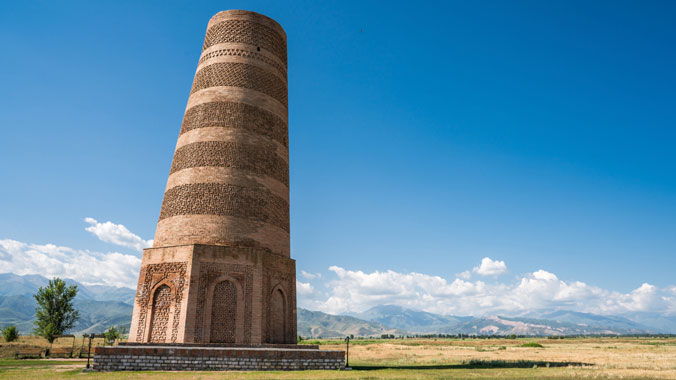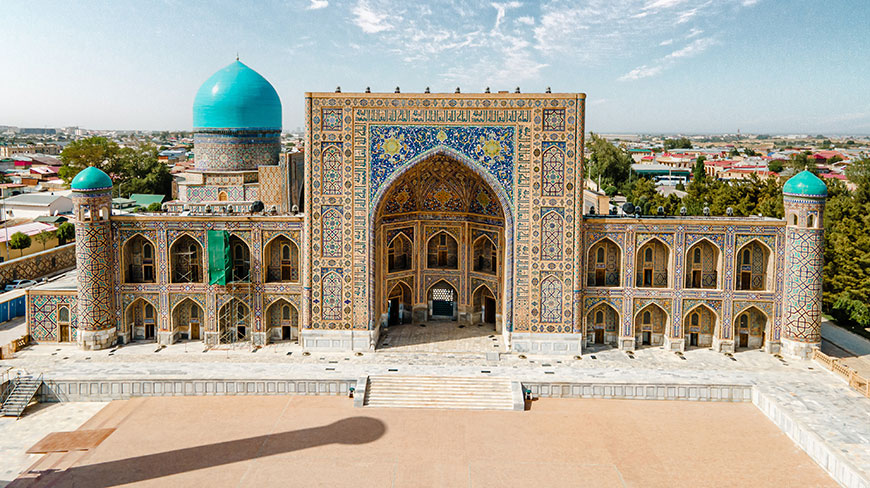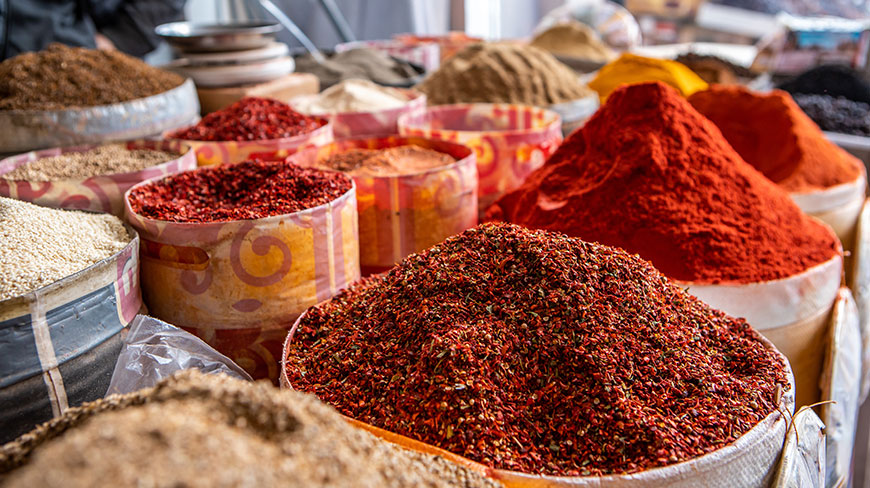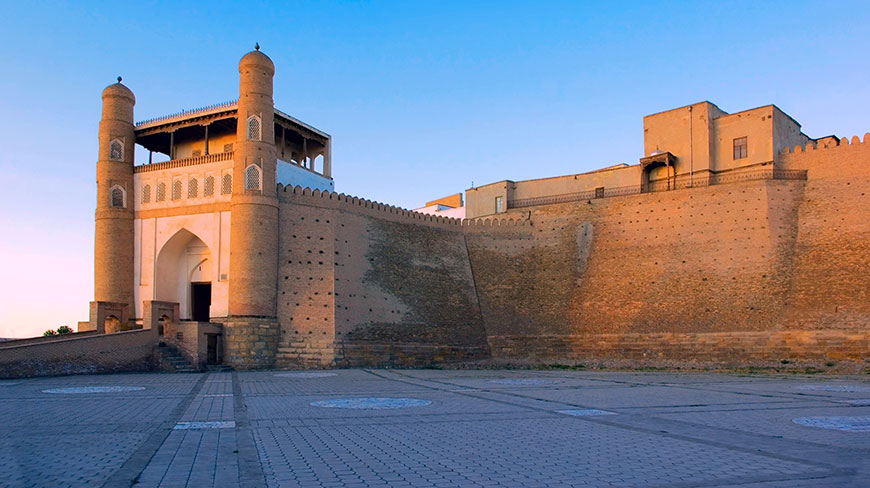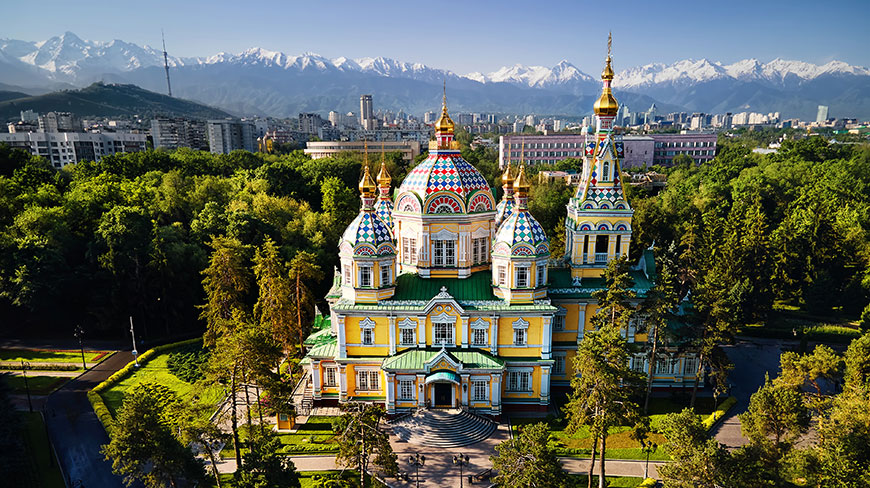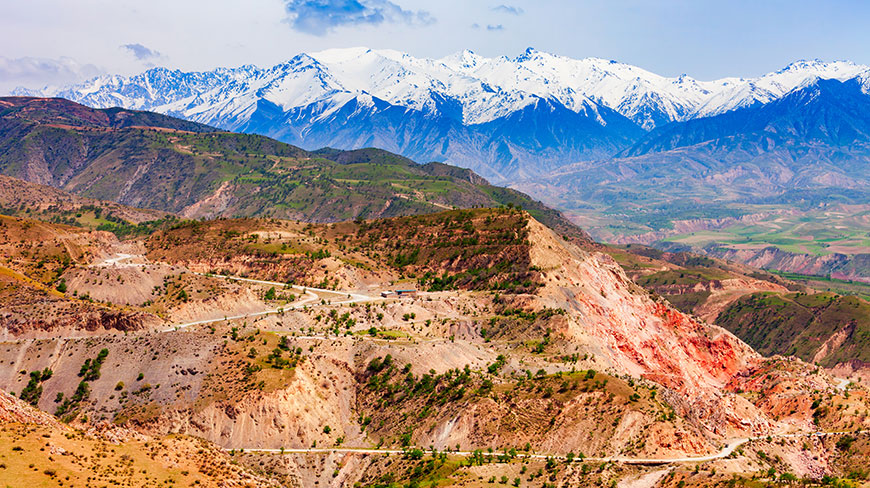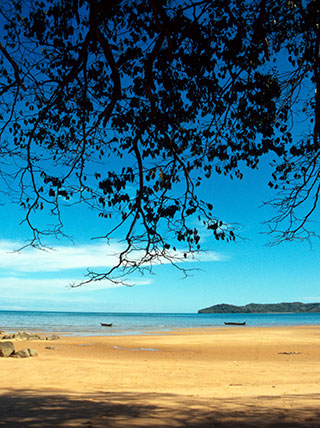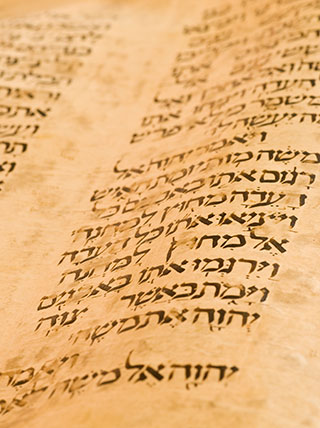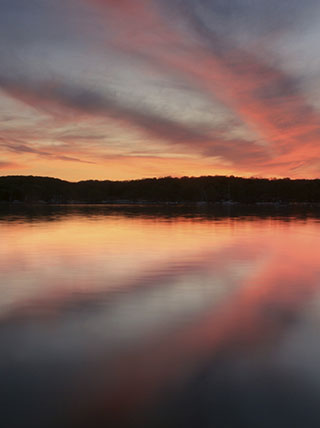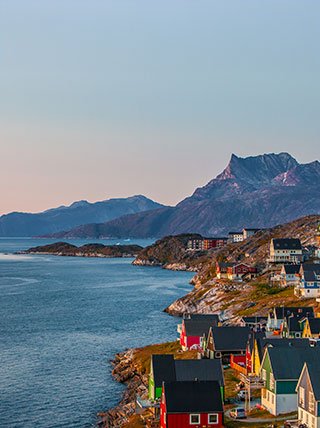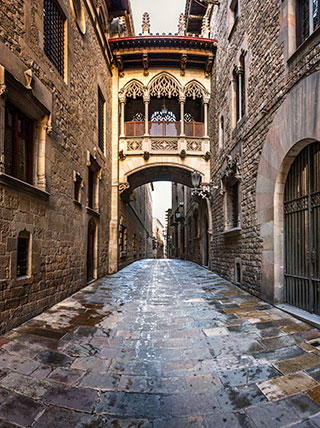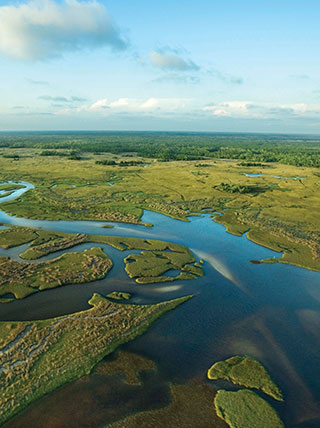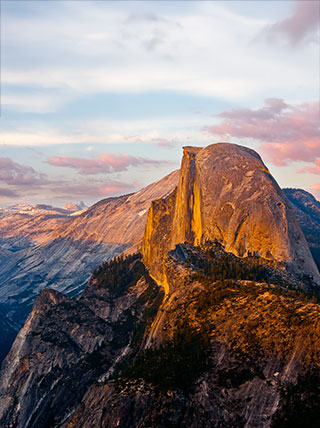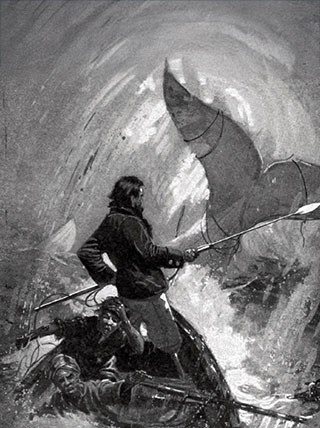Kazakhstan/Kyrgyzstan/Uzbekistan/Tajikistan/Turkmenistan
On the Silk Road in Central Asia
Program No. 18766RJ
Join experts to discover the preserved ruins, grand cities and cultural monuments that line the Silk Road, discovering how this ancient trade route altered the course of human history.
Enroll with Confidence
We want your Road Scholar learning adventure to be something to look forward to—not worry about. Learn more
Protecting the Environment
We offset a portion of the emissions created by your travel. Learn more
Itinerary
While we make every effort to ensure the accuracy of our published materials, programs are typically advertised more than a year prior to their start date.
Read More.
While we make every effort to ensure the accuracy of our published materials, programs are typically advertised more than a year prior to their start date. As a result, some program activities, schedules, accommodations, personnel, and other logistics occasionally change due to local conditions or circumstances. Should a major change occur, we will make every effort to alert you. For less significant changes, we will update you during orientation. Thank you for your understanding.
Duration
20 days
19 nights
What's Included
46 meals (
18B, 16L, 12D
)
5 expert-led lectures
54 expert-led field trips
2 flights during the program
2 hands-on experiences
3 performances
An experienced Group Leader
17 nights of accommodations
Taxes and customary gratuity
Road Scholar Assurance Plan
Day
1
Depart USA
Location:
In Flight
Activity Note
Overnight flight to Almaty, Kazakhstan
Day
2
In Transit to Program
Location:
In Flight
Activity Note
Connect via a gateway city en route to Almaty
Day
3
Transfer to the hotel, free day, orientation, welcome dinner
Location:
Almaty
Meals:
B,D
Stay:
Dostyk Hotel
Activity Note
This day is designated for recovery from international flights and adjustment to the change in time zone.
Breakfast:
Buffet at the hotel.
Morning:
This day is free to rest after the long flight and get used to the time change.
Lunch:
Explore local fare on your own.
Afternoon:
Meet your fellow participants at the orientation meeting this evening followed by the welcome dinner.
Dinner:
At a local restaurant, we will enjoy a welcome dinner, including a glass of wine, coffee, tea and water.
Day
4
Survey of the City, Falconry
Location:
Almaty
Meals:
B,L
Stay:
Dostyk Hotel
Activity Note
Getting on/off the bus; driving about 5 miles, approximately 30 minutes in total. Walking about 2 miles throughout the day on paved sidewalks and short distances on dirt pathways; periods of standing during field trips.
Breakfast:
Buffet at the hotel.
Morning:
Your introduction to Almaty includes the State Central Museum, with exhibits that detail the history of Kazakhstan and its people from the Bronze Age through the Russian Empire, the Communist Period and the present day. The centerpiece of the museum is a replica of the country’s chief archeological treasure, the Golden Man, a warrior’s armor made from 4,000 gold pieces. Later visit a falcon sanctuary where we will observe the birds and the gear the hunters use when they ride out into the country to hunt.
Lunch:
At a yurt restaurant, we will enjoy lunch and a Kazakh folklore performance.
Afternoon:
We will continue to Panfilov Park, a green oasis in Almaty’s central area, renamed by the Soviets in honor of 28 Kazakh soldiers, led by General Panfilov, who died on the outskirts of Moscow during WWII. Also in the park is Zenkov Cathedral, a wooden Orthodox church built at the turn of the century without the use of nails. Its yellow and green facade and golden domes are from the era of the czars. It is one of the few buildings in Almaty that came through the devastating 1911 earthquake. We will also visit Kok-Tobe, a 3,800-foot hill on the outskirts of Almaty with an aerial tramway leading to a recreation area at the top. The view of Almaty from Kok-Tobe is fantastic and gives a unique perspective on this sprawling, regional business capital.
Dinner:
Explore local fare on your own.
Evening:
At leisure.
Day
5
Drive to Bishkek
Location:
Bishkek
Meals:
B,L,D
Stay:
Golden Dragon Hotel
Activity Note
The distance from Almaty to Bishkek is approximately 150 miles (240 kilometers). Today's travel time is about 5 hours, including the border crossing. Border crossings may require traveling a relatively long distance on foot while handling your own baggage without assistance. The distance between the checkpoints at the Kyrgyzstan/Kazakhstan border is 300 meters.
Breakfast:
Buffet at the hotel.
Morning:
After breakfast, we will check out from the hotel and before departure to Kyrgyzstan, visit visit the Green Bazaar, where you one find all types of produce, nuts, and dried fruits. We will also stop at the Museum of Musical Instruments, which exhibits a collection of traditional Kazakh instruments, including the dombra, a two-stringed lute-like stringed instrument ubiquitous in Central Asia.
Lunch:
At a local restaurant, including coffee, tea, and water.
Afternoon:
Travel by private coach to Bishkek, Kyrgyzstan, changing vehicles at the border.
Dinner:
At the hotel restaurant, including coffee, tea, and water.
Day
6
University Visit, Burana Tower, Kyrgyz Family, Horse Games
Location:
Bishkek
Meals:
B,L,D
Stay:
Golden Dragon Hotel
Activity Note
Getting on/off the bus; driving about 150 miles, approximately 4 hours total. Walking about 2 miles throughout the day on paved and unpaved sidewalks in countryside; periods of standing during field trips. Spiral staircases at Burana Tower involve steep steps inside a narrow passageway with limited light (optional).
Breakfast:
Buffet at the hotel.
Morning:
Drive to the village of Tokmok, where we will visit a local university, which offers students the opportunity to receive a western-style liberal arts education with many classes conducted in English. International and Kyrgyz professors teach a full curriculum, including Business Management, IT, Chinese Language, International Relations, Law, and Psychology. Classes in Central Asian languages are also available to international and local students.
Lunch:
We will enjoy lunch as guests of a local family in neighboring Don-Aryk village.
Afternoon:
Following lunch, we will have an opportunity to meet the villagers, observe and participate in traditional Kyrgyz felt-making techniques with a local felt artist. Afterwards, attend a demonstration of Kyrgyz horse games, such as Ulak Tartysh, a sort of polo played with a goat carcass, and Kurosh, which is wrestling on horseback. On the way back to Bishkek, we will stop at Burana Tower, one of the only existing watchtowers on the Silk Road. Inside its small museum you'll see a collection of ancient bal-bals, carved stone figures used as monuments.
Dinner:
At a local restaurant, we will enjoy a glass of wine at dinner along with a concert of traditional Kyrgyz music and a Manas performance.
Day
7
City Tour, Fly to Tashkent
Location:
Tashkent
Meals:
B,L
Stay:
Hotel Navruz
Activity Note
Getting on/off the bus during city tour; driving about 10 miles, approximately 1 hour in total. Walking about 2 miles throughout the day on paved sidewalks and short distances on dirt pathways; periods of standing during field trips. The flight to Tashkent is 1 hour 20 minutes.
Breakfast:
Buffet at the hotel.
Morning:
The exploration of the city this morning includes visits to Victory Square, Oak Park with its stone sculptures, the Old Square and its replacement Ala Too Square, see the exterior of the House of Parliament, the White House, and the “Manas on a Horse” monument. Browse the collection at the State Museum of Fine Arts. Focusing on art created during the Soviet period, the State Museum of Fine Arts has a collection of more than 15,000 paintings, sculptures and decorative pieces. A permanent exhibition in the museum deals with Kyrgyz folk art and life, with a yurt, costumes and traditional crafts on display.
Lunch:
At a local restaurant, including coffee, tea, and water.
Afternoon:
Transfer to the airport for the one-and-a-half-hour evening flight to Tashkent, Uzbekistan. Upon arrival in Tashkent, transfer to the hotel in the city for a two-night stay.
Dinner:
Explore local fare on your own.
Day
8
New and Old Tashkent, Uthman Koran
Location:
Tashkent
Meals:
B,L
Stay:
Hotel Navruz
Activity Note
Getting on/off the bus; driving about 15 miles, approximately 2 hours in total. Walking about 2 miles throughout the day on paved sidewalks; periods of standing during field trips.
Breakfast:
Buffet at the hotel.
Morning:
We will stop by several important sites in new Tashkent: the Courage Monument, named for the workers who rebuilt the city after the earthquake; Independence Square, the history of which is revealed in its parade of names: first “Cathedral,” then “Red,” then “Lenin,” and finally in 1992, “Independence”; and the Shahid Memorial Complex, with its blue-domed rotunda, reminds the nation of the Uzbek leaders, artists and poets who were shot in 1938 during Stalin’s purges. In old Tashkent we will visit the Tillya Sheikh Mosque, where the Uthman Koran - considered by Sunni Muslims to be the oldest Koran in the world - is safeguarded in the library of the Tillya Sheikh Mosque. Written on deerskin 19 years after Mohammed’s death, the manuscript was compiled in Medina by Uthman, the third caliph of Islam. (Shi’a Muslims believe that Uthman’s successor, Ali, was the first true caliph, and they hold his version of the Koran to be the only true version.) Next, we will explore the Chorsu Bazaar. Open every day, the bazaar is at its most exhilarating on weekends, when traders and shoppers come in from outlying areas to buy and sell everything from spices and produce to woodwork and embroidery.
Lunch:
At a local restaurant, including coffee, tea, and water.
Afternoon:
Visit the Kukeldash Madrassah on a hill above Chorsu Plaza, one of the largest 16th-century madrassahs remaining in Central Asia. Constructed of baked brick with only one facade decorated in majolica and glazed bricks, the madrassah was part of an ensemble that marked the center of the old town and included the newly restored Juma Mosque. Browse the Applied Arts Museum, built by a wealthy czarist diplomat to Turkestan, Alexander Polovtsev, who admired Uzbek architecture. In 1898 he built the traditional mansion and invited artisans from Samarkand, Bukhara and Fergana to decorate the interior. Featuring the painted carved plaster, called ganche, carved wood, and tile work, the house itself is a main attraction. Exhibits include the Uzbek embroidered wall coverings called suzani, ceramics, jewelry, rugs, and musical instruments. Time permitting, descend to the city’s subway system, known as the Metro. Tashkent boasts the first metro in Central Asia. (The second is in Almaty.) Begun in 1977, each station has a different theme, some incorporating Central Asian decorative motifs and some resembling Russian palaces. With granite and marble, chandeliers and mosaics, the stations on Tashkent’s three lines are meant to be “art galleries for the people.”
Dinner:
Explore local fare on your own.
Day
9
Timurmalik Fortress, Muslihiddin Complex, Arbob Palace
Location:
Khujand
Meals:
B,L,D
Stay:
Sugdiyon
Activity Note
The distance from Tashkent to Khujand is approximately 120 miles. Today's travel time is approximately 3 to 4 hours, including time at the border. Border crossings may require walking a relatively long distance while handling your own luggage without assistance. The distance between the checkpoints at the Uzbekistan/Tajikistan border is 800 meters. Participants are advised to travel to Khujand with only an overnight bag and leave most of their belongings on the bus in Uzbekistan.
Breakfast:
Buffet at the hotel.
Morning:
We'll depart this morning for the border with Tajikistan. After the formalities of the border crossing, we'll continue to the nearby city of Khujand.
Lunch:
At a local restaurant upon arrival in Khujand, including coffee, tea, and water.
Afternoon:
Enter the Historical Museum of Sogdiana through a reconstructed medieval city gate. Displays here include ancient Sogdian artifacts and exhibits from more recent Tajik history. Wander the grounds of the Timurmalik Fortress. On the banks of the Syr Darya in the middle of Khujand are the remains of the Timurmalik 10th-century citadel, restored in 1999. Archeological excavations around the walls have uncovered artifacts from the 4th century BC. Explore the Muslihiddin Memorial complex. A 12th-century leader and poet, Muslihiddin Khudjandi is buried here in the complex, which has been rebuilt many times since his burial. Today the complex includes a 16th-century mosque and a 19th-century minaret, as well as the poet’s mausoleum. Khujand’s Arbob Cultural Palace is located in the central building of a former Soviet collective farm. Comprising a theater, museum, a hall that seats 1,000, fountains and formal gardens, the palace is the site where independence from the Soviet Union was declared. Named after two-time Hero of Socialist Labor, S. Urunkhodjaev, the Palace of Culture is considered a great example of 1950s architecture in Tajikistan. During Soviet times, Khujand was a strong socialist center with a mainly Uzbek population, and the country’s communist leaders often came from here.
Dinner:
At a local restaurant, including coffee, tea, and water.
Day
10
Pamir Mountains
Location:
Samarkand
Meals:
B,L,D
Stay:
Asia Samarkand Hotel
Activity Note
The distance from Khujand to Samarkand is approximately 200 miles. Today's travel time, including stops, is approximately 7 to 8 hours. The highest point on the drive is at approximately 10,000 feet.
Breakfast:
Early buffet at the hotel.
Morning:
Visit the exciting Panshanbe Bazaar. Khujand’s pink-painted, covered bazaar is overflowing with goods to buy. The huge columned structure shelters orderly rows of tables covered with bags of brilliant spices and nuts, straw-bedded melons with macramé handles, hanging haunches of meat and piles of vegetables. Afterwards, set the course through the beautiful Fann Mountains, driving along the Zeravshan Valley to Samarkand.
Lunch:
At a local restaurant, including coffee, tea, and water.
Afternoon:
Arrive in Samarkand and check in to our hotel in the early evening. Samarkand, perhaps the best known of the Silk Road towns, is a fabled oasis on the fringes of the Kyzyl Kum Desert that has been settled since the 6th century BC. Because of its location on the plains where the Zeravshan River spills out from the Pamir Mountains, Samarkand became a major Silk Road crossroads. It has been visited through time by many of the world's conquerors – Alexander the Great, Genghis Khan and Tamerlane. Alexander said of Samarkand, "Everything I have heard about the beauty of the city is indeed true, except that it is much more beautiful than I imagined." Tamerlane made it his capital city and gathered the finest architects, builders and artisans of the time to enhance its beauty.
Dinner:
At a local restaurant, including coffee, tea, and water.
Day
11
Highlights of Samarkand
Location:
Samarkand
Meals:
B,L,D
Stay:
Asia Samarkand Hotel
Activity Note
Getting on/off the bus; driving about 10 miles, approximately 1 hour in total. Walking about 2 miles throughout the day on paved sidewalks and short distances on dirt pathways; periods of standing during field trips. There is a fairly steep staircase with roughly 80 uneven steps without handrails at Shah-i-Zinde.
Breakfast:
Buffet at the hotel.
Morning:
Begin your introduction to Samarkand at Registan Square, the centerpiece of the city and its most recognizable landmark. Three emblematic madrassahs frame the square and loom over the empty space in the center. It was this central space that originally gave the place its name, for “registan” simply means “place of sand.” This sandy place was at the center of ancient Samarkand and was a public square and marketplace before Ulug Bek built the Ulug Bek, Tillya-Kori, and Shir Dor madrassahs. In its reconstruction, the square maintained the majesty that it has radiated through the ages. Visit Gur-Emir Mausoleum, the final resting place of Tamerlane, built at the turn of the 15th century. The interior of the mausoleum has been restored and is brilliant in gold leaf and fresh tile. The heavily gilded central dome opens over a set of tomb-markers resembling sarcophagi. All are marble, with the exception of Tamerlane's, which is a slab of solid jade, reportedly from Mongolia. The Bibi Khanum Mosque, built by Tamerlane to be the largest mosque in the Islamic world, and dedicated to the memory of his favorite wife. Architects from India and Persia were brought in to build the mosque, and 95 elephants were used to transport the marble and other building materials from India to Samarkand. Browse the animated Siab Bazaar, just across the street from the Bibi Khanum Mosque. Vividly dressed women oversee neat stacks of brilliant produce and burlap sacks of nuts and spices. Uzbek and Tajik men in black and white skullcaps, called doppi, sell cabbage rolls and shashlik. For a pittance, an entrepreneur with a brazier of special incense will cleanse you of all bad luck.
Lunch:
At a local restaurant, including coffee, tea, and water.
Afternoon:
The row of tombs and mausoleums collectively called Shah-i-Zinde, or “place of a living king,” stretches between the present and the past. At its front is living Samarkand, while at its back are the dusty slopes at the edge of ancient Afrosiab. Even on hot summer days, the mausoleums remain shady and cool. Behind the complex and set into the hill lies a cemetery with gravesites dating from the 9th century to the present. Visit the local Carpet Factory Workshop, where you may observe the entire process of dying thread and weaving carpets, and a traditional paper mill, complete with a water wheel, where the 7th-century art of making Samarkand silk paper has been revived.
Dinner:
Enjoy dinner tonight as guests of a local family.
Day
12
Drive to Bukhara, Gijduvan Ceramics, Jewish Heritage
Location:
Bukhara
Meals:
B,L
Stay:
Alexia Hotel
Activity Note
The distance from Samarkand to Bukhara is approximately 170 miles. Today's travel time is approximately 5 to 6 hours including stops.
Breakfast:
Buffet at the hotel.
Morning:
We'll continue along the Silk Road to Bukhara, making a stop at a ceramics master’s home and studio in the town of Gijduvan to learn about traditional ceramics and take a private tour of his workshop.
Lunch:
We'll take our meal with a ceramics master in his home.
Afternoon:
Upon arrival in Bukhara, we'll take an orientation walk around the center of the Old Town with a focus on Jewish Heritage. In the heart of the Old Town in the mid-19th century is where 2,500 families of prosperous merchants were estimated to have been living. Cut off in the 15th century from contact with other Jews, the Bukharan Jews developed their own dialect of the Tajik-Persian language that incorporates many Hebrew words, their own style of dress and their own unique form of Judaism. The only Bukharan synagogue allowed by the Soviets to remain is an unassuming place near the Lyabi-Hauz pool. Almost underground and still somewhat run-down, the synagogue is the center of life for Bukhara’s greatly diminished Jewish community. Since the dissolution of the Soviet Union, more than 70,000 Jews have left Uzbekistan.
Dinner:
Explore local fare on your own.
Day
13
Bukhara Old Town, Kalon Assembly, Ark Citadel
Location:
Bukhara
Meals:
B,L,D
Stay:
Alexia Hotel
Activity Note
Walking about 4 miles throughout the day on paved sidewalks, dirt pathways, and uneven cobblestones and stairs; periods of standing during field trips.
Breakfast:
Buffet at the hotel.
Morning:
With the feel of a true oasis in an oasis town, the Lyabi-Hauz plaza is at the center of Bukhara's old town. The atmosphere is cooled by the long rectangular reflecting pool that makes up the center of the plaza, and by the shade of the trees that ring the plaza. The mulberry trees here are hundreds of years old and frame the 16th- and 17th-century madrassahs that make up three of the four edges of the ensemble. Poi Kalon, also called the Bukhara Forum, includes the Kalon Mosque and Minaret, and the Mir-i-Arab Madrassah, and surrounds an open plaza teeming with merchants and local vendors. The Kukeldash Madrassah on the north side of the Lyabi Hauz reflecting pool is the largest Koranic school in Central Asia. The Khanaka of Nadir Divan-Begi was the first component of the Lyabi-Hauz ensemble, built even before the reflecting pool. The massive structure was originally a place of study and meditation for traveling Sufis. Two phoenixes spread their wings on each side of a shining sun on the archway that leads into the Nadir Divan-Begi Madrassah. Seated on the east side of the Lyabi-Hauz pool, the 1622 madrassah was originally built as a caravanserai.
Lunch:
At a local restaurant, including coffee, tea, and water.
Afternoon:
We'll continue to Ark Citadel, the original fortress of Bukhara that likely dates back two thousand years or more. The current structure has been built and rebuilt on the same site throughout its history and has preserved something of the form, purpose and function of the first ark. Like the medieval castle complexes of Europe, the Bukhara Ark served the Emirs of Bukhara as a residence, audience hall and as protection from neighboring enemies. While at the Ark Citadel, we'll attend a lecture given by a member of the senior scientific staff on archaeological excavations and discoveries in the Bukhara region. Just behind the Ark Citadel is the infamous Zindan Prison and the even more infamous “bug pit” or “black hole,” the cell where two of Britain’s finest Great Game players, Colonel Charles Stoddart and Captain Arthur Conolly, were imprisoned before their execution. In a clearing in a tree-filled park, a small plaza is marked with a single building, the Ismael Samani Mausoleum. It is the 10th-century resting place of Ismael Samani, founder of the (Persian) Samanid Dynasty. It was buried under centuries of sand until discovered in the 20th century. Though small, it is detailed in a fashion not seen in many other Bukharan monuments. More than sixteen styles of brickwork adorn the face of this memorial, and their elaborate pleats and layering are still fresh today. The Chashma Ayub Mausoleum (Job's Well) is not a true mausoleum, but a qadamdjoy, or site visited by a holy person. The Koranic prophet, Ayub, the Biblical prophet, Job, reportedly struck the ground with his staff here, and water immediately bubbled up from a spring. The oldest part of this multi-domed building was probably built in the 12th century. Under its many roofs are the sacred spring and the Water Supply History Museum of Bukhara.
Dinner:
Dinner this evening includes a presentation in the art of making plov (or pilaf), Central Asia’s most ubiquitous dish.
Day
14
Nakshbandi Necropolis, Palace of Moon and Stars, Chor Minor
Location:
Bukhara
Meals:
B,L
Stay:
Alexia Hotel
Activity Note
Getting on/off the bus; driving about 10 miles, approximately 1 hour in total. Walking about 2 miles throughout the day on paved sidewalks and short distances on dirt pathways; periods of standing during field trips.
Breakfast:
Buffet at the hotel.
Morning:
The mausoleum of Bakhaudin Nakshbandi, a 14th-century Sufi mystic and founder of the Nakshbandi order of Sufis, is a complex that grew from a simple tomb over his grave to a 16th century hostel for visiting dervishes, then to a spiritual complex in the 17th century with a mosque added in the 18th century. We'll explore the Summer Palace of the last emir and its Museum of National Crafts, located a short distance outside of the city. The Palace of Moon and Stars, or the Summer Palace of the last Emir of Bukhara, was built at the turn of the century after the Russians took control of Bukhara. The palace itself is something of a showpiece, as it was designed to keep the emir in luxury, but removed from the city, in isolation and politically impotent. The main palace is a mixture of local materials, regional influences and Russian style. Western furniture abounds, but design choices reflect traditional Uzbek decorations. We'll admire the early 19th-century Chor Minor Madrassah, whose four slender, blue-topped minarets give it its name. Then, we'll pay a visit to the Artisan Development Center for a private seminar and demonstration, led by several resident artists, on the history of regional crafts. The goal of the center is to revive and re-develop ancient handicrafts. The many different workshops include puppet makers, coppersmiths, cloth printers, wood carvers, gold and silk embroiderers and jewelry makers.
Lunch:
At a local restaurant, including coffee, tea, and water.
Afternoon:
Free time to be spent at your leisure.
Dinner:
Explore local fare on your own.
Day
15
Drive through the Desert to Khiva
Location:
Khiva
Meals:
B,L,D
Stay:
Asia Khiva Hotel
Activity Note
The distance from Bukhara to Khiva is about 280 miles. The drive will take approximately 7 to 8 hours including stops.
Breakfast:
Buffet at the hotel.
Morning:
Today depart Bukhara for Khiva. Travel by a private coach across long stretches of the Kyzyl Kum, or Red Sands, Desert. This is the same route ridden by loaded Silk Road camel caravans and once plagued by brigands on hand to plunder their riches. The landscape is made up of dunes, saxaul bushes and the distant mountains. Along the way you may catch glimpses of the Amu Darya River, which used to be called the Oxus, and loosely parallels the Uzbek-Turkmen border.
Lunch:
We'll have a picnic lunch at a local café along the way.
Afternoon:
Arrive in Khiva in time for a short guided walk around the Old Town at dusk before dinner at the hotel’s restaurant.
Dinner:
At the hotel restaurant, including coffee, tea, and water.
Day
16
Walk Through Ancient Khiva
Location:
Khiva
Meals:
B,L,D
Stay:
Asia Khiva Hotel
Activity Note
Walking about 4 miles throughout the day on paved sidewalks, dirt pathways, and uneven cobblestones and stairs; periods of standing during field trips.
Breakfast:
Buffet at the hotel.
Morning:
We'll spend the day exploring Khiva's Old Town, or Ichon-Qala, on foot. The Kunya Ark was originally built in the 12th century as the khan’s fortress and residence, and encompassed numerous small courtyards surrounded by administrative buildings, sleeping quarters, kitchens, guardhouse, stables, parade area and weapons strongholds. Much of it was lost when Persia invaded the Khivan Khanate in the 18th century, but what remains, including the mosque, harem and throne room are beautifully decorated with ceramic tiles and majolica. We'll continue with visits to the Mukhammad Rakhimkhan Madrassah and the Said Alauddin and Pakhlavan Makhmud Mausoleums before lunch.
Lunch:
At a local restaurant, including coffee, tea, and water.
Afternoon:
Wood carving is a traditional specialty of Khiva, and more wooden columns are found at the Dzhuma Mosque. The mosque is partially below ground level and the 115 carved columns that support the wooden ceiling create a forest-like effect around two square light wells. The walled Old City was an independent entity and the seat of the Khanate of Khiva. The largest of the existing buildings is the Tash Hauli Palace, the home of the Khan and his four legal wives. The intricate blue and white tile-work in the open-air throne room offsets the airy space set aside by the carved wooden columns.
Dinner:
At a local restaurant, we'll enjoy dinner and a performance of Khorezmian music and dance.
Evening:
We'll return to the hotel around 9:00 p.m.
Day
17
Cross the Uzbek-Turkmen Border, Dashoguz, Fly to Ashgabat
Location:
Ashgabat
Meals:
B,L,D
Stay:
Archabil Hotel
Activity Note
The distance from Khiva to Dashoguz, Turkmenistan is 45 miles, and the drive will take approximately 3 hours, most of which will be at the border crossing. The flight to Ashgabat is 40 minutes.
Breakfast:
Buffet at the hotel.
Morning:
This morning, you may join a field trip to Nurillaboy Palace or spend this time at your leisure. The Nurillaboy, or Isfandiyar, Palace was built at the turn of the 20th century as a summer residence for the Khivan khans and served as a reception area for foreign guests, as well. The palace was reconstructed in 2017, with seven rooms returned to their former grandeur in a mix of European and Eastern designs.
Lunch:
At a local restaurant, including coffee, tea, and water.
Afternoon:
We'll drive the short distance to the Uzbekistan/Turkmenistan border. After completing the formalities of crossing the border, which can be time consuming, we'll be met by our Turkmen local expert and driven to the nearby town of Dashoguz.
Dinner:
At a local restaurant in Dashoguz, including coffee, tea, and water.
Evening:
We'll take the late evening flight over the Kara Kum (black sands) Desert to Turkmenistan’s capital, Ashgabat.
Day
18
Highlights of Ashgabat, Akhal-Tekke Horse Ranch
Location:
Ashgabat
Meals:
B,L,D
Stay:
Archabil Hotel
Activity Note
Getting on/off the bus; driving about 20 miles, approximately 2 hours in total. Walking about 2 miles throughout the day on paved sidewalks and short distances on dirt pathways; periods of standing during field trips.
Breakfast:
Buffetat at the hotel.
Morning:
We'll stop at the Arch of Neutrality for a brief photo stop this morning. Turkmenistan's first president, Saparmurat Niyazov, had the 250-foot Arch of Neutrality, on which a 40-foot golden statue of himself revolved to continuously face the sun, built and placed in the main square. In 2011, current President Berdimuhamedov moved it to the Berzengi Settlement and renamed it the "Monument" of Neutrality. Stroll through Independence Park, a huge green space lined with monuments and statues in the center of the city, and admire the stately Ertugrul Ghazi Mosque, inaugurated in 1998. Designed to be reminiscent of Istanbul’s Blue Mosque, the white marble building with its four minarets has an interior decorated with stained glass. Visit the National History and Ethnography Museum. With its grand approach and panoramic views, the museum introduces modern Turkmenistan on the ground floor and ancient history in the galleries above. The historical exhibits begin with artifacts ranging from stone-age tools to carved ivory drinking horns. Other galleries display weapons, applied arts, such as carpets and jewelry, and the flora and fauna of Turkmenistan. The museum also features a fantastic selection of Turkmen carpets.
Lunch:
At a local restaurant, including coffee, tea, and water.
Afternoon:
After lunch, we'll visit the horse-breeding ranch devoted to the renowned Akhal-Tekke horse, arguably the oldest cultured breed of horse in the world. The owner or director makes a presentation of the breed while his assistants – often his children – demonstrate varieties of the breed in the yard. These elegant horses have slender necks, small heads, long legs and narrow chests. They are said to have lent their genes to both the Arabian horse and the American Quarter Horse. Before returning to Ashgabat, stop at Anau, which has been inhabited since Neolithic times. Archaeologists have recently uncovered evidence of a sophisticated town from around 2300 BC, the time of the early cities of Mesopotamia and ancient Iran. Up until a severe earthquake in 1948, Anau was well known for its beautiful 15th-century mosque, decorated with a tiled mosaic of two dragons. Although the site of the old mosque is today mainly of interest to archeologists, a new mosque has arisen, built of bricks from the rubble of the old one. And next to the site stands the equivalent of a picnic pavilion with rows of huge gas-powered vats for the preparation of large quantities of food. Locals rent the pavilion to celebrate various types of holidays and jubilee dates.
Dinner:
At a local restaurant, including coffee, tea, and water.
Day
19
Ancient Nisa, Kipchak Mosque, Russian Bazaar
Location:
Ashgabat
Meals:
B,L,D
Stay:
Archabil Hotel
Activity Note
Getting on/off the bus; driving about 15 miles, approximately 1.5 hours in total. Walking about 2 miles throughout the day on paved sidewalks and short distances on dirt pathways; periods of standing during field trips.
Breakfast:
Buffet at the hotel.
Morning:
This morning, we'll explore ancient Nisa. More than two thousand years ago the Parthian Empire spread out from Nisa and took its place among such kingdoms as the Achaemenid under Cyrus the Great and the Macedonian under Alexander the Great. Though Nisa was ruled by a succession of dynasties, it remained an important center in the ancient world until the 13th century, when the Mongols sacked it. Today archaeological work continues at Nisa, declared a UNESCO World Heritage Site in 2007. A local archaeologist will accompany us on our field trip to the excavations, which continue to reveal more about this ancient city. Then, we'll make a photo stop at Kipchuk village to admire Turkmenbashi’s personal mosque. The huge $100-million-dollar mosque in former Turkmen President Niyazov’s hometown of Kipchuk was inaugurated in 2004. The mosque is big enough to hold 10,000 people, and its 164-foot golden dome had to be lowered in place by helicopter. Verses from Niyazov’s own spiritual book, the Ruhnama, are etched on the walls alongside Koranic verses. Niyazov was buried here in the family mausoleum that he built, along with the mosque, with government funds. Before lunch, we'll explore the Russian Bazaar, a large, covered market selling all kind of foodstuffs, including prepared foods, fruits, nuts, vodka, high quality caviar and traditional breads. Before independence, this was where most ethnic Russians would shop, but today anyone is welcome. Turkmen women in traditional dress make up the majority of the sales force. Photography here is strictly forbidden.
Lunch:
At a local restaurant, including coffee, tea, and water.
Afternoon:
Enjoy a free afternoon to rest and prepare for the early-morning departure the next day.
Dinner:
At a local restaurant, we will enjoy a farewell dinner, including a glass of wine.
Evening:
After dinner, before returning to hotel, enjoy a view of Ashgabat from the overlook near the city’s gaudy wedding palace.
Day
20
Program Concludes
Meals:
B
Breakfast:
Most flights depart Ashgabat very early in the morning before hotel's restaurant opens for breakfast. Packed continental breakfast will be arranged.
Please select a day to update the map
Map details are not available for this location.

